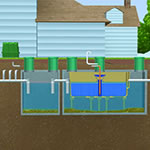Air Pohoda Ultima iERV (pictured above)
The experiences with Passive Houses in North America and Europe largely have been excellent, but the tricky matter of air quality has vexed a few projects. The challenge is to ensure healthy air at optimal humidity while minimizing the need for mechanical heating and cooling.
In some parts of the world, the solution is earth tubes. However, those have proven to be disastrous in the United States and Scandinavia, where some Passive House occupants contracted mold-related diseases. (Not to mention the variation in climate—outside air in Stuttgart is far different than air in, say, San Diego.)
To meet this demand, Czech Republic-based Air Pohoda has developed heat- and energy-recovery ventilators specifically made for high-performance and Passive House construction. Its most innovative product is the Ultima iERV, which can capture almost 100 percent of moisture leaving a home while allowing the homeowner to select the precise moisture retention level.
“The impetus behind our innovative iERV was to maximize household comfort and minimize primary energy usage under any environment through intelligent humidity control and high efficiency,” says Daryl Jacobson of Air Pohoda USA. “We’re fully functional at -30°C (-22°F) without any pre-heating of outdoor air.”

Despite our population’s increasing respect for the water cycle—recognizing the importance of managing and recycling water in efficient, Earth-friendly ways—arid and drought-plagued areas continue to look for better ways to manage what little water they have. These regions require smart wastewater and stormwater technologies that meet their unique needs. Consider the Middle East and North Africa region. Several countries, including the United Arab Emirates (UAE), source almost all potable water by way of desalinated seawater, an expensive and energy-intensive process, while groundwater is dedicated to agriculture.
But what if wastewater could be treated and reused? This was the question one employer asked, hoping to recycle treated wastewater for reuse in toilets and other non-potable uses such as curing concrete. After all, the employer’s 5,000 construction workers create about 500 cubic meters (132,086 gallons) of sewage per day.
Enter Bio-Microbics’ MicroFAST treatment system. MicroFAST uses a simple, low-cost, and robust technology to solve a gamut of on-site wastewater treatment issues. The product combines an attached or suspended, aerobic or anaerobic treatment process that recirculates nitrified wastewater to the primary settling chamber for automatic denitrification. Impurities are then digested, creating a clear, odorless,
high-quality effluent that is reusable for most non-potable applications.

Allegion Schlage NDE Wireless Locks
The wireless technology revolution, by definition, knows no bounds. It not only enables personal communication but also opens up new ways of doing business. For example, smart parking meters and car- and bike-share depots, many of which are fueled by the sun, can be neatly installed in a matter of weeks—no pavement disruption necessary.
Smart access management systems can be similarly enabled by wireless technology, with environmental and economic benefits to building owners. “Ninety percent of commercial real estate openings don’t have electronic locks yet largely because they are cost prohibitive,” says April Dalton-Noblitt, director of vertical marketing at Allegion. She describes how with Bluetooth wireless technologies smarter door lock capabilities can be installed in those buildings without running wires and or replacing doors. “There is so much material waste in current systems,” she says.
The firm’s Schlage NDE wireless locks, which use battery energy only when activated, will roll out in October 2015. Dalton-Noblitt notes that recycled content in the lock hardware also qualifies for LEED points. The locks fit the common Schlage hole pattern, enable usage monitoring, and offer control access rights through the company’s Engage app.

